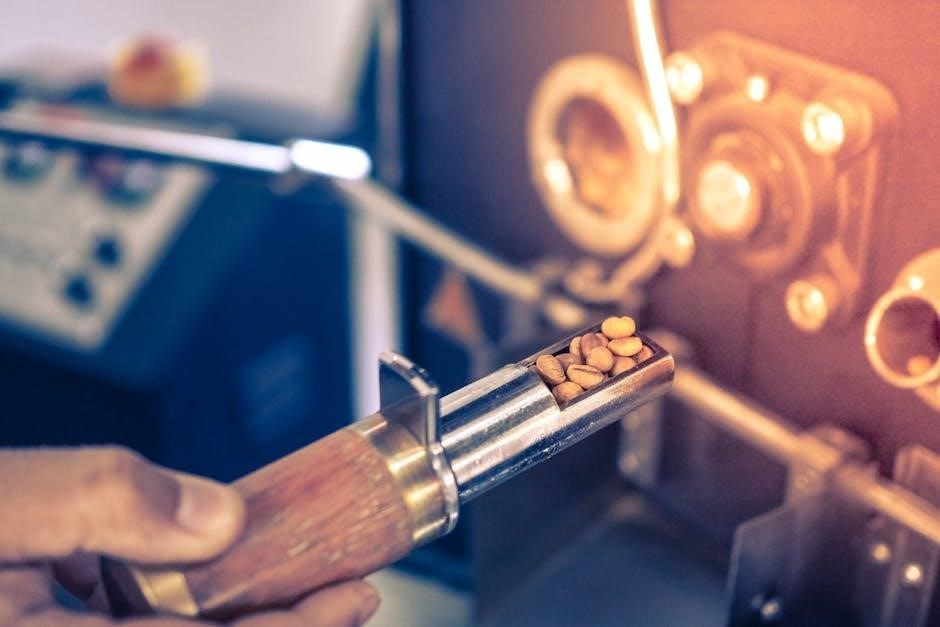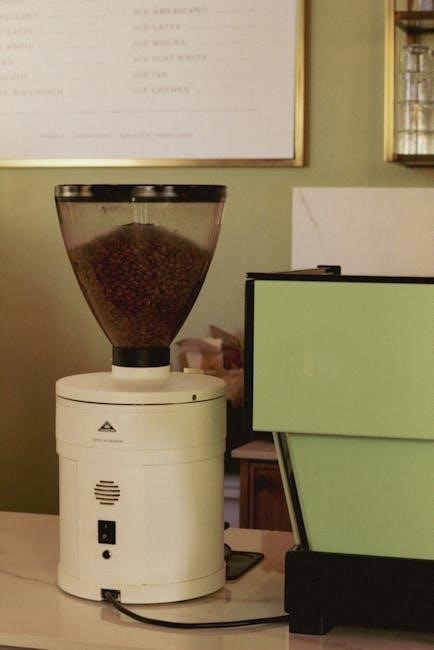Coffee grinding is a foundational step in coffee preparation, transforming raw beans into a liquid experience. Proper grinding enhances flavor, aroma, and overall coffee quality, making it essential for any coffee lover to master.
Why Grinding Your Own Coffee Matters
Grinding your own coffee is crucial for preserving flavor and aroma, as pre-ground coffee loses its essence quickly. It offers control over grind size, suiting various brewing methods like French press or espresso. Burr grinders provide consistent grinds without heat damage, ensuring balanced extraction. Investing in a grinder can be cost-effective and allows exploration of different beans and roasts, enhancing your coffee experience through experimentation and customization.

The Benefits of Freshly Ground Coffee
Freshly ground coffee delivers vibrant flavors and aromas, as grinding releases essential oils locked in beans. Pre-ground coffee loses these qualities quickly, often oxidizing and becoming stale. By grinding at home, you control the process, ensuring maximum freshness. This enhances the overall taste, making every brew more satisfying. Whether using blade or burr grinders, freshly ground beans provide a richer experience, allowing you to explore the full potential of your coffee. It’s a simple step that significantly elevates your daily ritual, making it worth the extra effort for coffee enthusiasts seeking the best flavor.
Types of Coffee Grinders
Coffee grinders come in various styles, including blade, burr, and manual or electric models. Each type offers unique benefits, catering to different needs and preferences for coffee enthusiasts.
Blade Grinders vs. Burr Grinders
Blade grinders use spinning blades to chop coffee beans, offering convenience and affordability. However, they can generate heat, potentially altering the coffee’s flavor. Burr grinders, on the other hand, crush beans between two surfaces, ensuring consistent grind sizes without heat buildup. This makes burr grinders ideal for preserving coffee’s aroma and flavor. While blade grinders are suitable for casual use, burr grinders are preferred by coffee enthusiasts for their precision and ability to customize grind sizes for various brewing methods like espresso or pour-over. The choice between them depends on personal preference, budget, and desired coffee quality. Choose wisely for your perfect cup.
Conical Burr vs. Flat Burr Grinders
Conical and flat burr grinders differ in design and performance. Conical burrs feature a cone-shaped design, offering excellent heat dissipation and consistent grind sizes, ideal for home use. Flat burrs, with their parallel surfaces, are often used in commercial settings, delivering high-speed grinding but potentially generating more heat. Conical burrs are generally quieter, easier to clean, and require less maintenance, while flat burrs excel in precision and durability for heavy-duty use. Both options produce high-quality grinds, but the choice depends on your brewing needs, budget, and preference for convenience versus performance. Each has its strengths, catering to different coffee enthusiasts’ requirements.

Understanding Grind Size and Distribution
Grind size and distribution are critical for optimal coffee extraction. The right grind size varies by brewing method, ensuring balanced flavor and aroma. Even distribution ensures consistency.
Common Grind Sizes for Different Brewing Methods
Coffee grind size varies significantly depending on the brewing method. Espresso requires a fine grind for high-pressure extraction, while French press needs a coarse grind to prevent over-extraction. Pour-over and Aeropress methods typically use a medium-coarse grind, allowing for optimal water flow and flavor extraction. Drip coffee makers often use a medium grind, similar to kosher salt, for balanced extraction. Cold brew, on the other hand, uses an extra-coarse grind to steep for extended periods without bitterness. Understanding these grind sizes ensures the perfect balance of flavors for any brewing technique.
The Importance of Even Grind Distribution
Even grind distribution is crucial for achieving balanced extraction in coffee. Uneven particles can lead to under-extracted or over-extracted flavors, resulting in a bitter or sour taste. Proper distribution ensures all grounds are in contact with water uniformly, maximizing flavor potential. This consistency is especially vital in methods like espresso and pour-over, where precise control over extraction is key. Even distribution also prevents channeling, where water flows unevenly through the coffee bed, bypassing some grounds entirely. By ensuring an even grind, you can unlock the full flavor profile of your coffee beans and enjoy a more satisfying brewing experience.
How to Choose the Right Grinder for Your Needs
Selecting the ideal grinder involves considering your brewing methods, budget, and preferences. Whether you opt for manual or electric, ensure it suits your daily coffee routine.
Factors to Consider When Buying a Coffee Grinder
When purchasing a coffee grinder, prioritize features like grind size adjustability, consistency, and durability. Consider your budget and whether you prefer manual or electric operation. Blade grinders are affordable but may generate heat, affecting flavor. Burr grinders, while pricier, offer precise control and uniform grinds. Additionally, assess the grinder’s capacity, ease of cleaning, and noise level. For espresso enthusiasts, a high-quality burr grinder is essential. Read reviews to ensure the grinder aligns with your brewing methods and lifestyle, ensuring optimal performance for your coffee-making needs.
Manual vs. Electric Grinders: Pros and Cons
Manual grinders are cost-effective, portable, and produce consistent grinds with minimal noise. They require manual effort and are ideal for small batches. Electric grinders are faster, handle larger quantities, and are convenient for daily use. However, they can be noisy and more expensive. Manual grinders suit those who value simplicity and control, while electric grinders appeal to those seeking efficiency. Consider your budget, lifestyle, and brewing habits when deciding. Both options offer unique advantages, so choose based on what aligns with your coffee-making routine and preferences.

Best Practices for Grinding Coffee
Consistency is key for optimal flavor. Adjust grind size based on brewing method, from fine espresso to coarse French press. Store beans properly and clean grinders regularly for freshness and hygiene.
How to Achieve the Perfect Grind for Espresso
Achieving the perfect espresso grind requires precision. The grind must be fine, almost powdery, to ensure proper extraction. Use a burr grinder for consistency, as blade grinders can generate heat, damaging beans. Adjust the grind setting to match your espresso machine’s requirements. Testing is crucial—pull a shot and observe the flow. If it’s too slow, the grind is too fine; too fast, and it’s too coarse. Store beans in an airtight container to preserve freshness and flavor. Regularly clean and maintain your grinder to prevent old coffee oils from affecting taste. Experimentation is key to finding your ideal grind.
Grind Settings for Pour-Over, French Press, and Other Methods
Grind size varies significantly across brewing methods. For pour-over, a medium-coarse grind is ideal to ensure proper water flow and extraction. French press requires a coarse grind to prevent grounds from passing through the press. Aeropress works best with a fine to medium grind, while drip coffee makers typically use a medium grind. Cold brew, on the other hand, needs an extra-coarse grind for steeping. Adjusting your grinder for each method is key to achieving balanced flavor. Use a burr grinder for consistency, as blade grinders can generate heat and uneven particles. Experiment with settings to find the perfect grind for your preferred brewing technique.

Maintenance and Care of Your Grinder
Regularly clean your grinder with a soft brush or cleaning solution to remove residue. Lubricate moving parts and sharpen or replace burrs as needed for optimal performance.
How to Clean and Maintain Your Coffee Grinder
Cleaning your coffee grinder regularly is essential to remove residual coffee oils and dust. Use a soft brush or a cleaning solution specifically designed for grinders. For manual grinders, disassemble and wipe down parts with a damp cloth. Electric grinders may require descaling to prevent mineral buildup. Always unplug before cleaning and avoid harsh chemicals that could damage components. For stubborn residue, grind a small amount of rice to absorb oils. Regular maintenance ensures optimal performance and prevents stale flavors. Check for static cling in burrs and lubricate moving parts if necessary. A well-maintained grinder lasts longer and brews better coffee.
Sharpening and Replacing Burr Sets
Sharpening and replacing burr sets is crucial for maintaining your grinder’s performance. Over time, burrs wear down, leading to inconsistent grinds. Sharpening can extend their life, but eventually, replacement is necessary. For manual grinders, check if burrs are adjustable or removable for sharpening. Electric grinders often require specialized tools or professional servicing. When replacing, ensure new burrs match your grinder’s specifications. High-quality burrs improve grind consistency and flavor. Always follow the manufacturer’s instructions for sharpening or replacing to avoid damaging your grinder. Regular maintenance ensures optimal grinding and prevents costly repairs down the line.
Troubleshooting Common Grinding Issues
Identify and address issues like inconsistent grinds, clogged grinders, or motor overheating; Regular cleaning, burr maintenance, and adjusting grind settings can resolve most common problems effectively.
Dealing with Inconsistent Grinds
Inconsistent grinds can ruin your coffee experience. Blade grinders often cause uneven particles, while burr grinders are more precise. To fix this, ensure your grinder is clean and free of old coffee residue. Adjust the grind settings carefully, as different brewing methods require specific particle sizes. For example, espresso needs a fine, even grind, while French press requires a coarser texture. If using a burr grinder, check for worn-out burrs and sharpen or replace them as needed. Regular maintenance and proper calibration can significantly improve consistency and flavor in your coffee.
Fixing Clogged Grinders and Other Common Problems
Clogged grinders are a common issue, often caused by oil from coffee beans or improper cleaning. To fix this, unplug the grinder and brush out any residue. For stubborn clogs, soak removable parts in warm soapy water. Regularly cleaning your grinder prevents buildup and ensures smooth operation. Other issues like uneven grinds can be resolved by adjusting settings or sharpening burrs. Proper maintenance, such as descaling and lubricating moving parts, extends the life of your grinder. Always refer to the manufacturer’s guidelines for specific troubleshooting steps to keep your grinder functioning optimally.
Mastering coffee grinding unlocks the full flavor and aroma of your beans, elevating every brew. Experiment, explore, and refine your skills to find your perfect cup every time.
Summarizing the Key Points of Coffee Grinding
Coffee grinding is a crucial step that significantly impacts the flavor and quality of your brew. Freshly ground beans ensure optimal aroma and taste, while pre-ground coffee often lacks freshness. Burr grinders are preferred over blade grinders for consistency and even extraction. Understanding grind sizes is essential, as different brewing methods require specific textures, from fine espresso grinds to coarse French press. Regular maintenance, including cleaning and sharpening burrs, ensures longevity and performance. Experimentation with grind settings and techniques can elevate your coffee experience, helping you achieve the perfect cup tailored to your preferences.
Encouraging Experimentation and Exploration
Experimentation is the heart of mastering coffee grinding. Try different beans, roast levels, and grind sizes to discover unique flavors. Adjust settings for each brewing method to find your perfect balance. Keep a journal to track what works and refine your technique. Don’t be afraid to explore new tools or methods—each can reveal new dimensions in your coffee experience. Remember, coffee is a journey, and every cup is an opportunity to learn and enjoy something new. Embrace the process and savor the creativity that comes with crafting your ideal brew.
